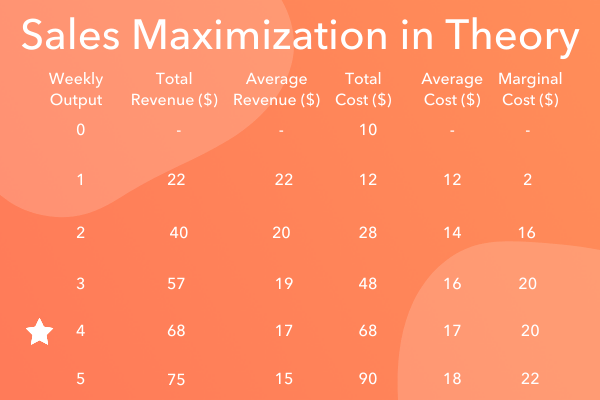Sales maximization is inherently unsustainable. It's impossible to consistently generate maximum revenue without sacrificing profits and ultimately kneecapping your company's growth.
It's a short-term solution — only taking place in small sporadic windows. It's always carried out with intention and generally executed with specific strategies. Sales maximization is something of a jumping-off point and a bit of a gamble. It's a process meant to spur customer interest and set sales in motion, but there's no guarantee that will be the case.
The endgame of sales maximization is the same as virtually any other business strategy: profit. Sales maximization is an investment. It's carried out in the hopes that the customers it attracts will be willing to stay on board once the maximation period is over and prices increase again.
If you implement a sales maximization strategy that doesn't pan out, then you'll have lost valuable time and capital that could have been better allocated elsewhere.
How to Maximize Sales Revenue
Theoretically, sales maximization is achieved when a business sells as much of a product or service as possible without making a loss, meaning the average revenue of a product or service is the same as its average cost to produce it. This is often achieved by strategically lowering prices. Here is a numerical example of sales maximization in theory.

In the example provided above, an output of four units per week lets the business in question generate its maximum revenue at an equal degree of cost. If it were to ramp up to a weekly output of five units, it would incur a loss — making it financially unsound.
Though that might be the correct way to maximize revenue in theory. Companies don't always directly adhere to those standards. Many businesses implementing sales maximization wind up operating at a loss for however long they see fit.
Sales Maximization in Practice
Say you operate an ecommerce site that offers collectible mid-2000s John Cena action figures like the one pictured below.
.webp?width=196&height=499&name=Sales%20Maximization%20A%20Picture%20of%20Its%20Principles%20and%20Practice%20(1).webp)
As fate would have it, the market for these kinds of figures is cutthroat. The mid-2000s John Cena action figure game is absolutely dog-eat-dog. Several other retailers produce a similar product at a slightly lower price-point than you.
You're in a bind. You need more business, but it's hard to land new customers when your competitors are undercutting your prices. It takes $50 to produce your product, and you typically sell them for $80. Other retailers sell them for around $65.
Your ideal customers buy these figures on a surprisingly consistent basis, and you're confident in the quality of your product — relative to your competitors'. So, in an effort to claim more of a market share, you decide to maximize sales.
In this case, you might offer your figures for $50 for a month-long window. Hopefully, collectors will take notice and buy your product over your competitors'.
Ideally, your new customers will appreciate the quality of your product. You'll foster brand loyalty, and those new patrons will stay on board and continue buying your marquee mid-2000s John Cena action figures from then on out.
Ultimately, the decision of whether you want to implement a sales maximization strategy can come down to three main factors: time constraints, your budget, and your place in your competitive landscape.
You need to have a picture of how long you're willing to carry out a sales maximization strategy. How much time do you think it will take to achieve your goals?
You also need to consider your financial situation. Can you budget for the inevitable loss in profits? And finally, you have to take whether your product or service is attractive enough to retain the customers you acquire by lowering prices. How much faith do you have in your offering, relative to your competition?
If you're looking for new business and can check those three boxes, a sales maximization effort might be right for you.
Sales Strategy

.jpg)

.png)

![7 key sales challenges to prepare for in 2026 [+ how you can overcome them]](https://53.fs1.hubspotusercontent-na1.net/hubfs/53/sales-challenges-1-20251023-788058.webp)
![How B2C sales could shift in a recession [new data]](https://53.fs1.hubspotusercontent-na1.net/hubfs/53/Recession%20sales%20strategies%20(1).png)
![22 Best Sales Strategies, Plans, & Initiatives for Success [Templates]](https://53.fs1.hubspotusercontent-na1.net/hubfs/53/Best-Sales-Strategies-1.png)
![What Is Sales? A Quick Guide [+ Examples]](https://53.fs1.hubspotusercontent-na1.net/hubfs/53/what-is-sales-1-20250411-8755735.webp)

![What Is Cross-Selling? Intro, Steps, and Pro Tips [+Data]](https://53.fs1.hubspotusercontent-na1.net/hubfs/53/ft-cross-selling.webp)

